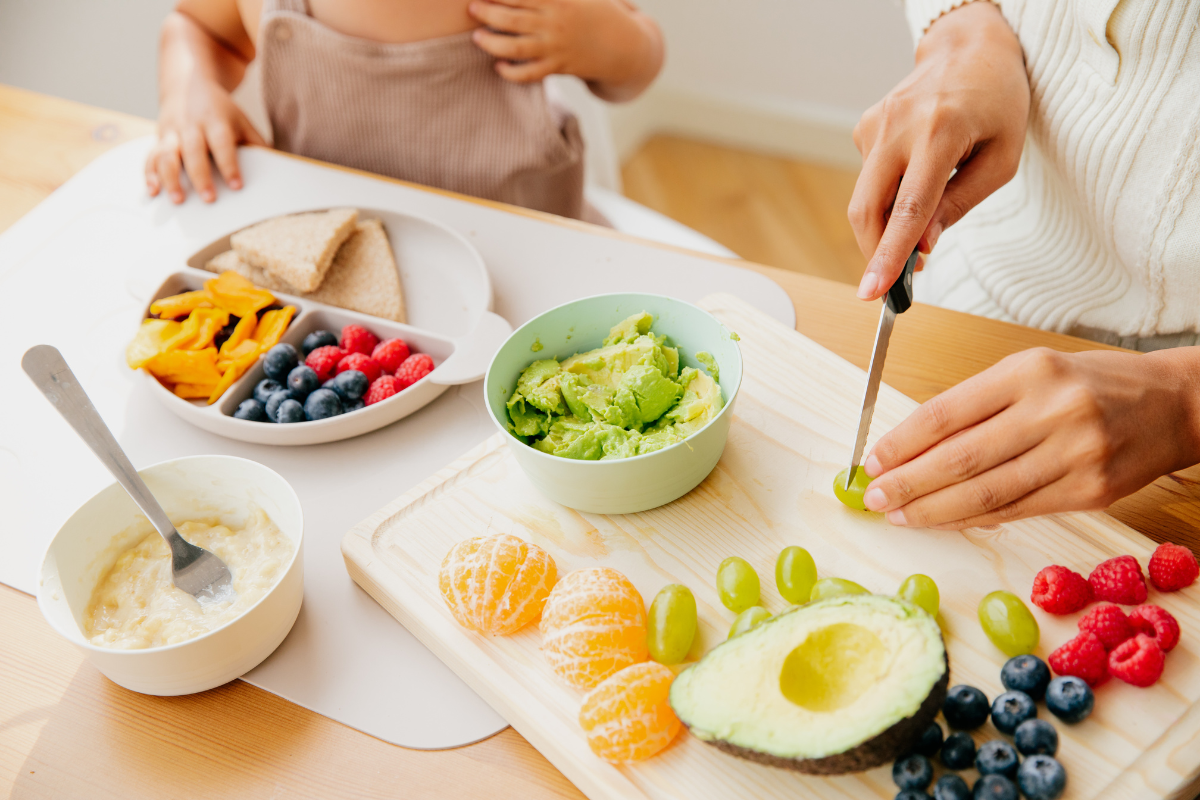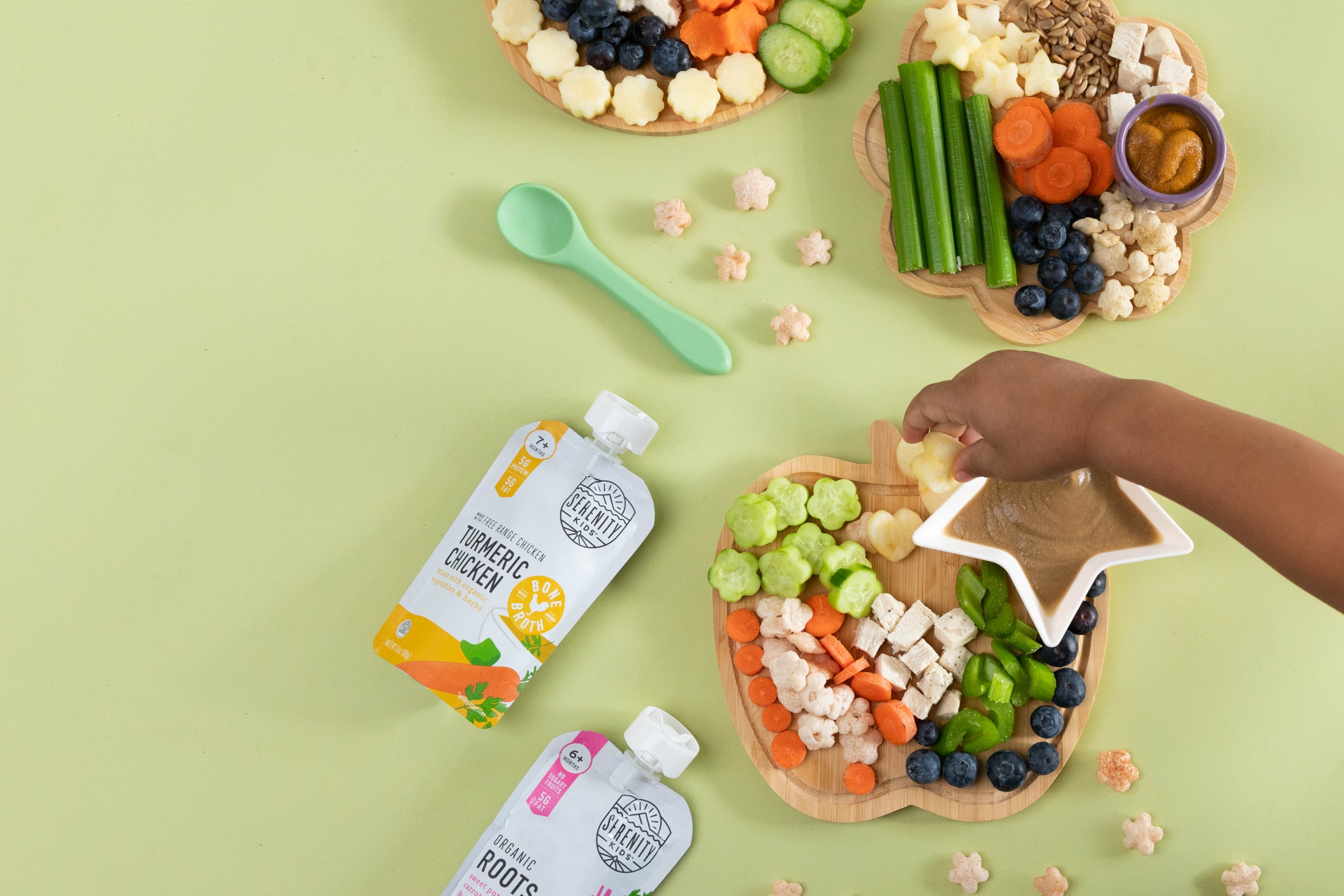We get it. Mealtimes can feel like battlegrounds when you're up against a tiny human whose taste buds seem to have a mind of their own. The frustration is real, the concern about their nutrient intake is constant, and let’s be honest—sometimes you just want them to eat all the foods you lovingly prepare, not beg for chicken fingers, grilled cheese, or fries again.
But take a deep breath—you’re not alone. Introducing healthy foods and new flavors to your picky eater is a journey, not a one-meal miracle. Celebrating every small “yes” is a huge win. At Serenity Kids, we believe in the power of flavor to inspire better eating habits. That’s why our grain-free baby and toddler foods are packed with whole, nutrient-dense ingredients to help develop adventurous palates. Because let’s face it—no one dreams of raising a picky adult who only eats bland meals.
Let’s embrace a world beyond grilled cheese and explore how to gently add new, exciting flavors—like sweet potatoes, blue cheese, or even brussels sprouts—to your child's plate, one bite at a time.
Understanding the Root of Picky Eating: Beyond the Myth of Defiance

Mealtimes with picky eaters can be draining. What might seem like defiance is often rooted in deeper, more complex factors. Understanding the “why” behind picky eating can help you support your child with patience and empathy. Here are some of the most common reasons your child might hesitate when it comes to trying new foods:
Sensory Sensitivities:
For many young children, the world is a sensory minefield—especially when it comes to foods. Picky eaters are often more sensitive to how food looks, smells, feels, or tastes. A child might avoid slippery or slimy foods, like cooked spinach or overripe fruit, because the texture feels uncomfortable or strange. Other kids might be overwhelmed by the crunch of raw veggies or the smell of strong cheeses. Even slimy foods like certain fruits or sauces can be deal-breakers for sensitive eaters.
The "Picky Eater" Stage: Understanding Toddler Development

The “picky eating” phase is a normal, if frustrating, part of toddlerhood—typically happening between ages 1 and 4. As toddlers grow, they crave independence, and asserting control at mealtime is one way they express it. They may refuse scrambled eggs one day and demand them the next. Or they’ll insist on familiar favorites like chicken fingers, avoiding anything unfamiliar.
This period is also marked by neophobia, a fear of new foods, which can make your efforts to expand their palate feel like an uphill battle. Just remember—this isn’t personal. It’s developmental. By staying calm and consistent, and by offering foods slowly without pressure, you’re helping your child build confidence in trying healthier options over time.
Approaching mealtimes with empathy and understanding can help your child navigate this phase and begin to love healthy foods. Celebrate their growing independence while gently encouraging them to explore new options. Offer a variety of healthy choices in a positive and relaxed environment, and remember that every bite, big or small, is a step towards a healthy and adventurous relationship with food.
Learned Behaviors:
Children are excellent observers, and they learn by watching and mimicking the behaviors of those around them. If a parent or older sibling expresses disgust or hesitation towards healthy meals, this can influence a child's perception of those foods, making them less likely to try them themselves.
Environmental Factors:
Mealtime environment and presentation can also play a role in a encouraging nutritional value in a child's diet. Creating a calm and relaxed atmosphere during mealtimes is crucial. Additionally, presenting food in an appealing and playful way can spark curiosity and encourage exploration.
By understanding the root causes of picky eating, parents can approach mealtimes with empathy and patience. Remember, many picky eaters are not expressing defiance, and their hesitation often stems from a variety of factors beyond a child's control. By creating a positive and supportive environment, offering a nutrient dense meal with healthy fats, and celebrating small victories, parents can help their picky eaters develop a healthy and adventurous relationship with food.
Strategies for Expanding Your Picky Eater's Palate
Leveraging the Flavor Window: A Head Start for Healthy Eaters

The "flavor window," roughly between 4 months and 2 years old, presents a unique opportunity to influence your child's future eating habits. During this period, they possess a heightened openness to new flavors, including bitter tastes often found in vegetables that they might reject later. This is where you can play a crucial role in mitigating picky eating tendencies.
Here are some ways to leverage the flavor window:
-
Introduce a wide variety of healthy foods: Offer a diverse selection of fruits, vegetables, whole grains, healthy oils (for example olive oil and avocado oil), and protein sources during mealtimes and snacks. This exposes them to a broader flavor spectrum, increasing the chances they'll develop a liking for various tastes.
-
Don't shy away from vegetables: Although often met with initial resistance, persistently offer vegetables in different forms (steamed, roasted, pureed, etc.). Repeated exposure can help them overcome initial hesitance and potentially develop a taste for these essential nutrients.
-
Make mealtimes positive and engaging: Create a relaxed and enjoyable atmosphere at mealtimes. Allow your child to explore different foods with their senses, without pressuring them to eat everything. This fosters a positive association with food, encouraging them to be more open to trying new things.
Remember, the flavor window is just one aspect of influencing your child's eating habits. Consistency, patience, and positive reinforcement remain crucial throughout their development. By taking advantage of this window and fostering a healthy relationship with food, you can set your child on the path to becoming a well-rounded and adventurous eater.
Small bites, no pressure:
Don't overwhelm your child with large portions of unfamiliar food. Offer small, manageable bites and avoid pressuring them to eat it all.
The power of repeated exposure:
It can take multiple exposures for a child to develop a liking for a new food. Be patient and keep offering new options, even if they're initially rejected. With patience and persistence, the vegetable puree will become one of their favorite foods!
Mix and match:

Pair new foods with familiar favorites to create a sense of comfort and encourage exploration. For example, serve broccoli florets alongside their favorite cheese cubes. Green beans, pumpkin puree, sweet potatoes, apple chips, and nut butter make additions to your child's daily diet.
Flavor bridges:
Introduce new flavors or foods by pairing them with something your child already enjoys. Offer a new fruit alongside greek yogurt or dip a veggie stick in a familiar hummus, or dip roasted chickpeas in low sugar ranch dressing.
Don't give up:
Consistency is key! Even if your child consistently rejects a new food initially, keep offering it in different ways and with patience, they might eventually come around.
Make it Fun!

Get the kids involved: Let your little ones participate in age-appropriate food preparation tasks. Washing vegetables, stirring ingredients, or choosing fruits and vegetables at the store can all be engaging activities that spark their interest in food.
Shapes and colors: Use cookie cutters to create fun shapes out of vegetables or fruits. Arrange foods in colorful patterns on the plate to make mealtime visually appealing.
Dips and sauces: Offer healthy dips and sauces like hummus or yogurt to add flavor and encourage dipping unfamiliar vegetables.
Sneaky additions: Finely chop or puree new vegetables into familiar dishes like pasta sauce or omelets. This is a great way to add extra nutrients without overwhelming your child's taste buds.
Storytelling with food: Create fun stories around foods. Talk about where the food came from or create a silly character based on a fruit or vegetable. This can help make mealtime more engaging and memorable.
Serenity Kids Recipes to Spark Excitement for New Flavors
Visit our website for a variety of delicious and easy recipes! We offer a range of smooth, chunky, and customizable options to cater to different texture preferences. Here are a few examples to get you started:
-
Dreamsicle Smoothie: This vibrant smoothie includes our Squash puree mixed with orange and lemon juice, and our A2 Whole Milk formula for a delicious, creamy treat.
-
Summer Burger: Our kid-friendly Summer Burger uses our Salmon pouch combined with veggies and seasonings.
Explore the exciting flavor combinations of our new World Explorers Pouches! These recipes feature unique ingredient combinations, like our Salmon Teriyaki or our Coconut Curry Chicken, to introduce your child to a world of new tastes and cultures.
Together on the Flavor Journey: Celebrating Every Step of the Way

Celebrate small wins: Focus on celebrating progress, no matter how small. Did your child take a bite of a new food for the first time? Did they touch or smell a new vegetable? These small steps are all part of the journey to expanding their palate.
It's okay to take breaks: Remember, even the most patient parents can get frustrated. It's completely normal to need a break! Take a deep breath, step away from the table, and come back to the situation with a fresh perspective and a positive attitude. Sometimes, a simple "poker face" can avoid creating any additional pressure for your little one.
Build your community: You're not alone in this journey! Connect with other parents facing similar challenges with picky eaters through our online communities and resources. Share experiences, swap tips, and offer support to each other. Remember, we're all in this together!
Conclusion:

Be patient and persistent: Expanding a child's palate takes time and patience. Don't get discouraged by setbacks, celebrate every small victory and keep introducing new flavors consistently.
It's not about perfection: There's no such thing as a "perfect" eater, and that's okay! Focus on fostering a positive relationship with food and building healthy eating habits, and the rest will follow.
Support network: Serenity Kids is here to support you with your picky eater every step of the way. We offer delicious recipes, helpful resources, and a supportive community to help you navigate the exciting, sometimes messy, world of introducing new flavors to your little one. Let's embark on this flavor adventure together!









































